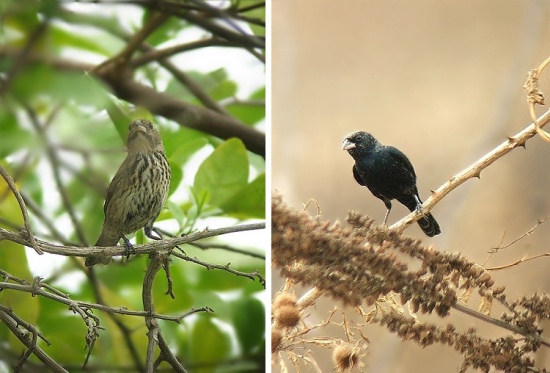- Volatinia jacarina
Identification
8·7–10·9 cm (3½-4¼ in)
Male
- Blue-black
- Black tail and wings
- White inner underwing
- Slim conical black bill
Female and immature: brown upperparts, buff, dark streaked underparts.
Distribution
Central and South America and the Caribbean:
Central Americal: Mexico, Guatemala, Belize, El Salvador, Honduras, Nicaragua, Costa Rica, Panama
Caribbean (West Indies): Lesser Antilles, Windward Islands, Grenada, Trinidad, Tobago, Netherlands Antilles
South America: Colombia, Venezuela, Guyana, Suriname, French Guiana, Ecuador, Peru, Bolivia, Brazil, Paraguay, Uruguay, Chile, Argentina
Taxonomy
Subspecies
There are 3 subspecies[1]:
- V. j. splendens:
- Northern Mexico to northern South America, Grenada, Trinidad and Tobago
- V. j. peruviensis:
- V. j. jacarina:
Habitat
Open terrain, scrub, savannas, second growth, rice and corn fields, xerophytic areas; grasslands, agricultural lands, roadsides, parks and wooded lands.
Behaviour
Breeding
When displaying, they jumps vertically from its perch about 1 foot in the air and utters a high pitched 'Pee-Zing' and then with a downward half-somersault lands on its perch again.
It builds a small cup-shaped nest. The clutch consists of 1-4 pale green eggs blotched with reddish brown. Both sexes incubate for 9–10 days and the young fledge about 9-10 days later.
Diet
The diet consists mainly of grass seeds, but other seeds are included. They will also eat some insects and berries.
References
- Clements, J. F., T. S. Schulenberg, M. J. Iliff, D. Roberson, T. A. Fredericks, B. L. Sullivan, and C. L. Wood. 2017. The eBird/Clements checklist of birds of the world: v2017, with updates to August 2017. Downloaded from http://www.birds.cornell.edu/clementschecklist/download/
- Avibase
- BF Member observations
- Handbook of the Birds of the World Alive (retrieved May 2018)
- Wikipedia
Recommended Citation
- BirdForum Opus contributors. (2024) Blue-black Grassquit. In: BirdForum, the forum for wild birds and birding. Retrieved 28 April 2024 from https://www.birdforum.net/opus/Blue-black_Grassquit
External Links
GSearch checked for 2020 platform.1






